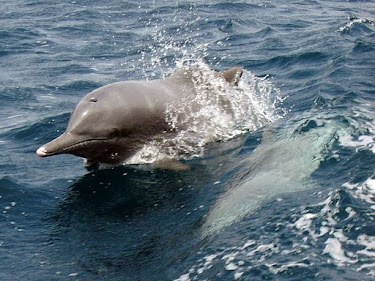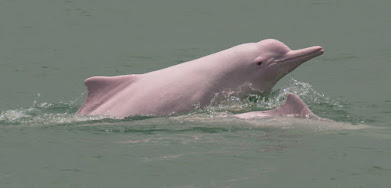Dolphins in critical state - List of most threatened species
Dolphins are
considered as a playful funny mammals found in theme parks jumping through the hoops
or racing with the boats. What we don’t think of are the problems we cause to
them. All over the world, various types of dolphins are in grave danger of extinction.
There are 40
different species of dolphins scattered around the world. We can see them along
rivers and coasts of South Asia, Southeast Asia, Mediterranean Sea, Atlantic
and Pacific regions. Off the 40 species, many are in critically endangered
conditions, mainly because of us, HUMANS!!
Yes, almost
all of the threats to the survival of these mammals are manmade. Fishing nets,
hooks, underwater mining processes, destruction of natural habitat, building
water reservoirs leading to dividing a species, pollution, pesticides, etc.,
are some of the threats the dolphins face.
Right now
there are various steps taken to make sure their survival. These include World
Wildlife Fund, a charitable organization which combines with the local partners
to take precautions and create a safe environment not only for dolphins, but to
almost all the endangered floras and faunas. Let’s dive in and discuss and get
to know some of the species of endangered dolphins.
Indian Ocean Humpback Dolphins
 |
| Indian Ocean Humpback Dolphin near Oman Credit: Mandy via Wikipedia Commons |
As the name indicates,
they are found across the coasts of South Asia, Persian Gulf, Arabian Peninsula
and Eastern African Coasts. They are classified as endangered species and are
found mostly found within 20 meters of the sea level. Their total population is
estimated to be around 10,000. Since this species is commonly found in shallow
waters, many are susceptible to collision with boats. Several common threats
like fishing gears, noise pollution and mining are several other threats.
Hector’s Dolphins
 |
| Hector's dolphins in Canterbury, New Zealand Credit: Tomas Sobek via Wikipedia Commons |
Named after the person who first examined the species, these dolphins are only found around the coasts of New Zealand. This species is labelled endangered and efforts are being made to ensure their safety. At present there are around 7381 dolphins of this kind. Mostly they are found around the South Island.
Maui Dolphins
One of the
two subspecies of Hector’s species, the Maui Dolphins is found near the west
coast of North Island. They are recorded as critically endangered in the IUCN
red list. Less than 100 animals of this species are currently alive.
South Asian River Dolphins
 |
| Gangetic River Dolphin Credit: Ravindra Kumar Sinha via DownToEarth |
Originally
thought to be two different species, the Indus River Dolphins and Ganges River
Dolphins are later found to be subpopulations of a same species. They are now
commonly called as South Asian River Dolphins. They are found in Indus and Ganges
Rivers and their tributaries. Due to high pollution levels, the population of
both the sub species dropped drastically. Now, due to local and contributions,
their numbers are beginning to rise. Right now, there are about 3,500 Ganges
dolphins and 1,816 Indus Dolphins present in the rivers of South Asia.
Atlantic Humpback Dolphins
 |
| Atlantic Humpback Dolphins Credit: WCS Congo |
Atlantic
Humpback Dolphins are found along the West African Coasts, mostly within the
Gulf of Guinea. These dolphins are found to be shy. They do not bow-ride or
jump out of the water. Yet there are reports that they engage in cooperative
fishing with Mauritanian fishermen by driving fishes towards their nets. They
are shallow dwellers and sometimes get caught before ships and nets. The
population of this species is estimated to be only around 1500.
Fiordland Bottlenose Dolphins
 |
| Fiordland Dolphins Credit: Cruise Milford |
This is a
subspecies of Bottlenose Dolphins found in Fiordland, New Zealand. They are
considered to be critically endangered. According to latest reports, there are
only 205 members are alive and only 123 are mature. Mining and shipping lanes
are some of the threats for these Fiordland natives.
Taiwanese Humpback Dolphins
 |
| Taiwanese Humpback Dolphin Credit: Lindsey Porter via Awesome Ocean |
Taiwanese
Humpbacks are subspecies of Indo-Pacific Humpback Dolphins found only near the
estuaries of West Taiwan Coast. These animals are easily distinguished from
other species. Adults are white or pale pink colored while the calves are
grey. Recent studies show that only 37-44 individuals are presently alive.
Irrawaddy Dolphins
 |
| Irrawaddy dolphins near Sunderbans, West Bengal Credit: Dibyendu Ash vis Wikipedia Commons |
The Irrawaddy
Dolphins are known for their resemblance to Killer Whales. Sometimes they are
not considered as the true dolphins. There are various subspecies found at 8
different regions from Eastern India to Philippines. There is no complete
survey, yet estimation shows that about 7,000 individuals are currently
surviving. The list of some of the subpopulation and their population are
listed below,
- Sunderbans - 5832
- Chilika Lake - 152
- Mekong River - 78-91
- Mahakam River - 70
- Malampaya Sound - 42
- Ayeyarwady - 58-72
- Songkhla Lake - 50
Gulf of Corinth Common Dolphins
 |
| Common Dolphins Credit: NOAA NMFS via Wikipedia Commons |
This
subspecies of Common Dolphins are found in the Gulf of Corinth, Greece. This is
by far the most endangered species of dolphins. At present there are only 10
members of the species alive. A marine mammal task force have been recently
formed to take care of this species and striped dolphins this semi enclosed
gulf according to IUCN regulations.
Baiji Dolphins
 |
| Baiji Dolphin Credit: Institute of Hydrobiology, Chinese Academy of Sciences via Wikipedia Commons |
Baiji is
possibly an extinct dolphin species. This species lived in the Yangtze River
situated in China. Their extinction is mainly because of the pollution of the
river and the associated lakes. The conservation efforts have failed miserably.
Few undocumented sightings have been reported, but there is no possible proof
for existence of the species.
Apart from
the above mentioned species, many different species are low in number. The
exact population and relevant data for these are not yet known. Such kinds include
Amazon river Dolphins, Burrunan Dolphins, Tucuxi, Chilean Dolphins, Costero,
Clymene Dolphins, etc.,.
Conclusion
As I have mentioned before, all the threats
leading to the downfall in dolphins’ numbers is mostly due to human needs. Not
only for dolphins but also for various kinds of amazing animals that completes
our world. This is not intentional. I think we have been doing things without
understanding or knowing all the consequences that follow afterwards. As the most
intelligent creatures, it’s on our shoulders to safeguard our ecosystems, our
Earth. What do you say? Will you agree?






No comments